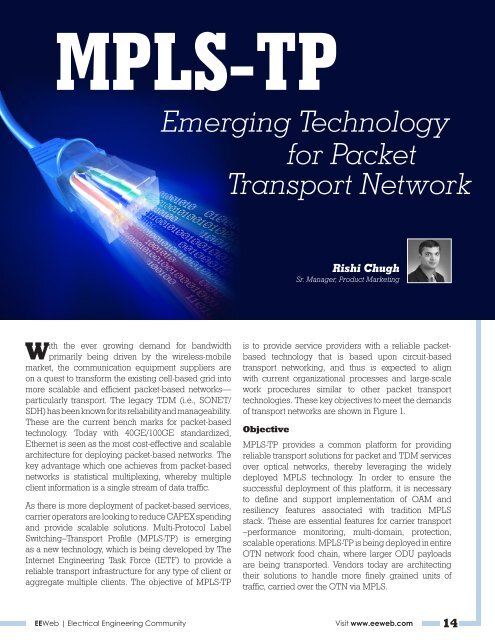EE Web PULSE
EE Web PULSE
EE Web PULSE
You also want an ePaper? Increase the reach of your titles
YUMPU automatically turns print PDFs into web optimized ePapers that Google loves.
MPLS-TP<br />
TECHNICAL ARTICLE<br />
With the ever growing demand for bandwidth<br />
primarily being driven by the wireless-mobile<br />
market, the communication equipment suppliers are<br />
on a quest to transform the existing cell-based grid into<br />
more scalable and efficient packet-based networks—<br />
particularly transport. The legacy TDM (i.e., SONET/<br />
SDH) has been known for its reliability and manageability.<br />
These are the current bench marks for packet-based<br />
technology. Today with 40GE/100GE standardized,<br />
Ethernet is seen as the most cost-effective and scalable<br />
architecture for deploying packet-based networks. The<br />
key advantage which one achieves from packet-based<br />
networks is statistical multiplexing, whereby multiple<br />
client information is a single stream of data traffic.<br />
As there is more deployment of packet-based services,<br />
carrier operators are looking to reduce CAPEX spending<br />
and provide scalable solutions. Multi-Protocol Label<br />
Switching–Transport Profile (MPLS-TP) is emerging<br />
as a new technology, which is being developed by The<br />
Internet Engineering Task Force (IETF) to provide a<br />
reliable transport infrastructure for any type of client or<br />
aggregate multiple clients. The objective of MPLS-TP<br />
Emerging Technology<br />
for Packet<br />
Transport Network<br />
Rishi Chugh<br />
Sr. Manager, Product Marketing<br />
is to provide service providers with a reliable packetbased<br />
technology that is based upon circuit-based<br />
transport networking, and thus is expected to align<br />
with current organizational processes and large-scale<br />
work procedures similar to other packet transport<br />
technologies. These key objectives to meet the demands<br />
of transport networks are shown in Figure 1.<br />
Objective<br />
MPLS-TP provides a common platform for providing<br />
reliable transport solutions for packet and TDM services<br />
over optical networks, thereby leveraging the widely<br />
deployed MPLS technology. In order to ensure the<br />
successful deployment of this platform, it is necessary<br />
to define and support implementation of OAM and<br />
resiliency features associated with tradition MPLS<br />
stack. These are essential features for carrier transport<br />
–performance monitoring, multi-domain, protection,<br />
scalable operations. MPLS-TP is being deployed in entire<br />
OTN network food chain, where larger ODU payloads<br />
are being transported. Vendors today are architecting<br />
their solutions to handle more finely grained units of<br />
traffic, carried over the OTN via MPLS.<br />
<strong>EE</strong><strong>Web</strong> | Electrical Engineering Community Visit www.eeweb.com 14<br />
TECHNICAL ARTICLE















